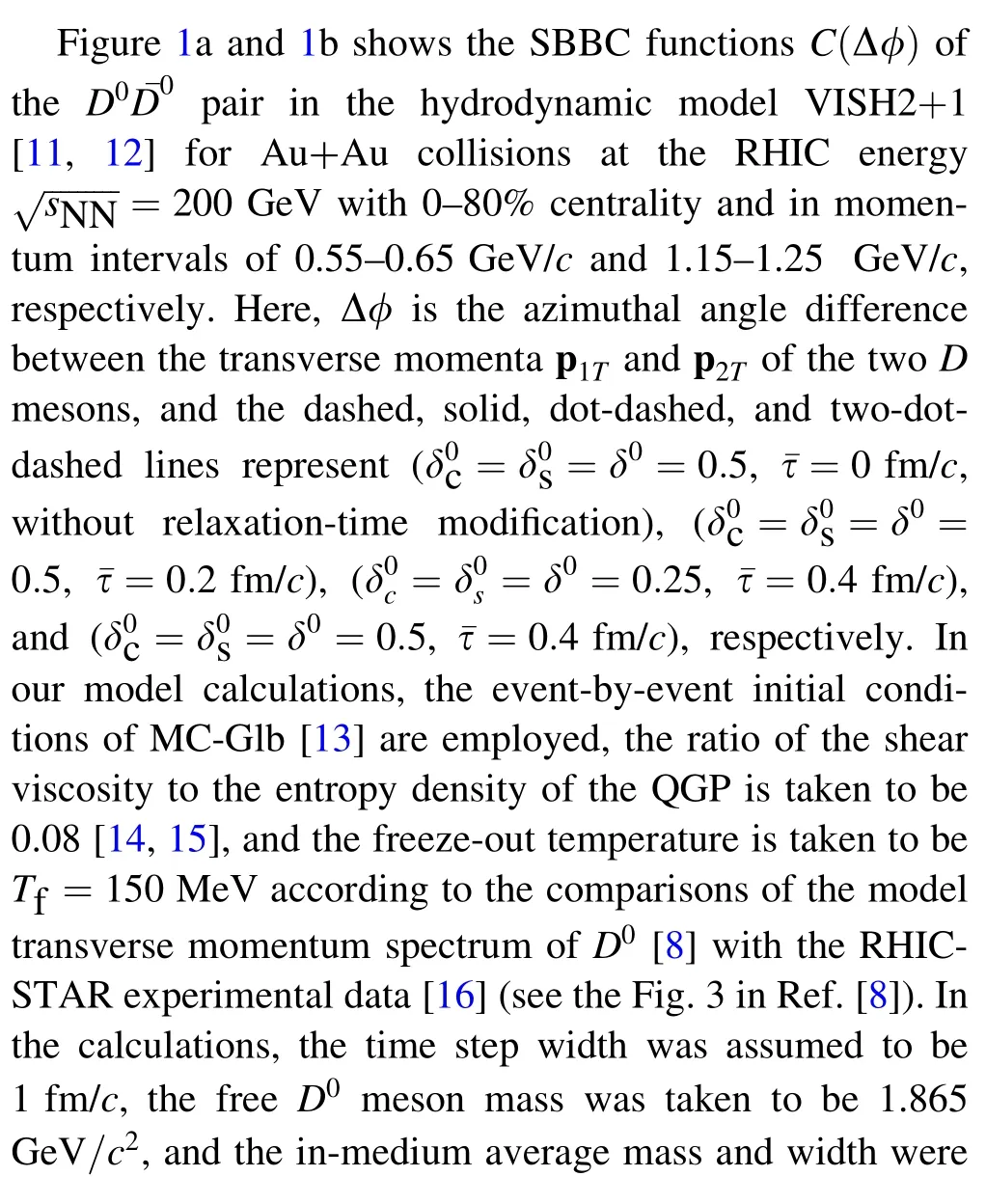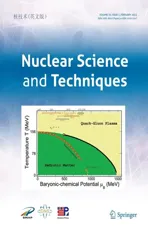Effect of relaxation time on the squeezed correlations of bosons for evolving sources in relativistic heavy-ion collisions
2022-05-13WeiNingZhangPengZhiXu
Wei-Ning Zhang· Peng-Zhi Xu
Abstract The squeezed back-to-back correlation (SBBC)of a boson-antiboson pair is sensitive to the time distribution of the particle-emitting source, and the SBBC function for an evolving source is expected to be affected by the relaxation time of the system. In this study, we investigated the effect of relaxation time on the SBBC function. We propose a method for calculating the SBBC function with relaxation-time approximation for evolving sources. SBBC functions of D0¯D0 in relativistic heavy-ion collisions were investigated using a hydrodynamic model.We found that the relaxation time reduces the amplitudes of the SBBC functions. This becomes apparent for long relaxation times and large initial relative deviations of the chaotic and squeezed amplitudes from their equilibrium values in the temporal steps.
Keywords Relaxation time · Squeezed back-to-back correlation · Evolving source · Relativistic heavy-ion collisions
1 Introduction
In relativistic heavy-ion collisions, the interactions between the particles in the sources lead to a modification of the boson mass in the sources and thus give rise to a squeezed boson-antiboson correlation[1,2].This squeezed correlation is caused by the Bogoliubov transformation between the creation and annihilation operators of the quasiparticles in the source and the free observable particles and forces the bosons and antibosons to move in opposite directions. Therefore, it is also known as a squeezed back-to-back correlation (SBBC) [1-3]. Measuring the SBBC of bosons can be used to get information about the interaction between the meson and the source medium and will be useful for understanding the properties of the particle-emitting sources [1-6].
Hydrodynamics has been widely used in relativistic heavy-ion collisions to describe the evolution of a particleemitting source. In the hydrodynamic description, it is assumed that the source system is under the local equilibrium,that is,it evolves in the so-called quasi-static process.However, the quasi-static process is a rough approximation.Because the SBBC is sensitive to the time distribution of the source, appropriately representing the temporal factors is of interest in the calculation of the SBBC function for an evolving source.
D mesons contain a heavy quark (charm quark) produced during the early stage of relativistic heavy-ion collisions.The SBBC of the D mesons is stronger than that of light mesons and useful for probing the source properties in the early stage [6-10]. This study proposes a method for calculating the SBBC function with the relaxation-time approximation for evolving sources. The effects of the relaxation time on the SBBC functions of D0¯D0in relativistic heavy-ion collisions are investigated using the hydrodynamic model VISH2+1 [11, 12]. We found that the SBBC functions decrease when the relaxation time is considered. The change in the SBBC functions increases with increasing relaxation time and becomes considerable for large relative deviations of chaotic and squeezed amplitudes at the beginning of their deviation from their equilibrium values.
The remainder of this paper is organized as follows: In Sect. 2, we present the formulas of the SBBC functions of evolving sources with relaxation-time approximation. In Sect. 3, we investigate the influence of the relaxation time on the SBBC functions of D0¯D0in relativistic heavy-ion collisions. Finally, a summary and discussion are given in Sect. 4.
2 Formulas



Fig. 1 (Color online) The SBBC functions of the D0 ¯D0 pair in the hydrodynamic model of Au+Au collisions at=200 GeV with 0-80%and 40-80% centralities and two momentum ranges



3 Results


4 Summary and discussion

Relaxation-time approximation is an usual approach for calculating quantities in a near-equilibrium evolving system. In viscous hydrodynamic models, relaxation times of shear and bulk viscosities are introduced, which may change the system’s space-time structure. However, the relaxation times associated with the quantities must be considered during calculations using the hydrodynamic model because they transition from a nonequilibrium to an equilibrium state in each temporal step. In addition, the relaxation time must be appropriately considered when calculating a sensitive time-depend observable.
Using a hydrodynamic model,one can obtain the source temperature as a space-time function. The final observed particles are assumed to be emitted thermally from a fourdimensional hypersurface at the fixed freeze-out temperature,which can be determined by comparing the calculated observables, for example, particle transverse-momentum spectra, with experimental data. In this study, we used the viscous hydrodynamic model VISH2+1 [11, 12] to determine the freeze-out hypersurface and calculate SBBC functions with and without the relaxation-time term δ0e-t′/¯τ. The relaxation time reduces the SBBC functions.This effect may be retained in an ideal hydrodynamic model although the viscosity changes of the freeze-out hypersurface.
Because the SBBC is caused by changes in the particle mass in the source medium, analyzing SBBC may become a new technique for getting information about particles inmedium interactions; however, there are no experimental data for comparison with the findings of the model when it is used in this manner. However, it is difficult to account for particle scattering in detail in a bulk evolution model.In our model calculations, we assume that D mesons have a mass shift and width, which are obtained from the FMFK calculations [8, 17, 18], in the sources because of the inmedium interactions.More detailed studies of the influence of particle scattering on the SBBC based on a cascade model (for instance, a multi-phase transport model[19, 20]) or a hybrid model (for instance, the hydro+-UrQMD model [21, 22]) will be pursued in the future.
Authors’ contributionsAll authors contributed to the study conception and design.Material preparation,data collection and analysis were performed by Wei-Ning Zhang and Peng-Zhi Xu.The first draft of the manuscript was written by Wei-Ning Zhang, and all authors commented on previous versions of the manuscript. All authors read and approved the final manuscript.
杂志排行
Nuclear Science and Techniques的其它文章
- Anisotropy flows in Pb-Pb collisions at LHC energies from parton scatterings with heavy quark trigger
- Development and application of a multi-physics and multi-scale coupling program for lead-cooled fast reactor
- A novel approach for radionuclide diffusion in the enclosed environment of a marine nuclear reactor during a severe accident
- Investigation of combined degrader for proton facility based on BDSIM/FLUKA Monte Carlo methods
- Anisotropic flow in high baryon density region
- Superconducting multipole wiggler with large magnetic gap for HEPS-TF
